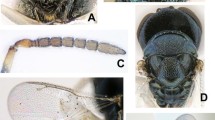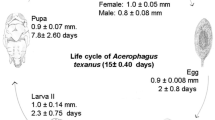Abstract
Lydella thompsoni Hertin,Tachinidae, is an endoparasitoid frequently associated in southern France with larvae ofOstrinia nubilalis, Pyralidae, Sesamia nonagrioides, Noctuidae, Archanara geminipuncta andA. dissoluta, Noctuidae. The tachinid was reared successfully at 21°C in the laboratory by providing the adult flies with a high humidity, a light intensity of 8,000–10,000 lux for mating and a mixture of casein proteolysate and honey as food. Under such conditions, the flies lived for about 30 days and about half of them mated successfully. Hosts were infested by dissecting mature tachinid females and placing 1–2 of the extracted planidia onto each moth larva. Half of the planidia successfully entered their larval hosts.
The biology of the tachinid larvae was studied on the 2 main hosts,O. nubilalis andS. nonagrioides. At 21°C, 25°C and 28°C, larval development took less time onO. nubilalis than onS. nonagrioides. At 25°C, female larvae onO. nubilalis required 9.0±0.5 days and onS. nonagrioides 10.5±0.3 days, male larvae onO. nubilalis required 8.3±0.5 days and onS. nonagrioides 10.6±0.3 days. Pupal duration was also influenced by the larval host. In winter, 2nd instar larvae ofL. thompsoni enter a resting or quiescent condition. This condition is terminated sooner (December–January) in larvae developing onS. nonagrioides than in those developing onO. nubilalis (February–March).
The life cycle of the tachinid in the field was studied by trapping flies in water dishes and by collecting parasitized host larvae from various plants. Flies were caught from April to October, mainly in September. Larvae of the spring generation of the parasitoid developed on larvae of species ofArchanara that fed on the reed,Phragmites communis. From 1976 to 1982, parasitism averaged about 16%. Parasitism by summer generation onS. nonagrioides was highest (4–5%) in June. Parasitism ofO. nubilalis did not change by more than 2 fold in either of the 2 summers studied (10–17 % in 1981, 6–10 % in 1982). By September the numbers of host larvae had increased to 10–20 times the number available earlier in the season. Larval populations ofL. thompsoni similarly increased from 3–400 larvae per ha in June to 4–5,000 per ha in September.
The stability of the relationship between this parasitoid and its hosts in southeastern France is discussed and compared to relationship described elsewhere.
Résumé
Lydella thompsoni Herting est un endoparasitoïde habituel des larves d'Ostrinia nubilalis Hübner,Sesamia nonagrioides Lefebvre etArchanara spp. Walker en France méridionale. L'élevage exige une humidité ambiante élevée et une intensité lumineuse supérieure à 8 000–10 000 lux pour l'accouplement. Les adultes sont alimentés par un protéolysat de caséine miellé. La survie atteint 30 jours à 21 °C. Le taux d'accouplement est de 50 %. La maturation des planidia demande 15 à 18 jours à 21°C. L'infestation des hôtes se réalise par dissection des femelles matures et dépôt de 1–2 planidia actives sur une larve de l'hôte. Taux d'infestation 50 %.
Le développement larvaire est étudié sur 2 hôtes:O. nubilalis etS. nonagrioides ⦏ 21, 25 et 28°C. Le développement est significativement plus rapide sur le 1cr hôte aux 3 températures et pour les 2 sexes du parasite: à 25°C, surO. nubilalis 9,0±0,5 jours contre 10,5±0,3 jours surS. nonagrioides pour les femelles et, surO. nubilalis 8,3±0,5 jours contre 10,6±0,6 jours surS. nonagrioides pour les mâles. La durée de la pupaison est influencée dans le même sens par l'hôte larvaire. L'hibernation se fait au 2e stade larvaire. Ce dernier est achevé plus rapidement surS. nonagrioides, décembre-janvier, que surO. nubilalis, février-mars.
Le cycle est étudié par piégeage des adultes de 1979 à 1983 et prélèvement des larves hôtes de 1976 à 1983. Les captures, pour les pièges à eau placés dans les parcelles de maïs, débutent en avril. Elles se poursuivent sporadiquement jusqu'en septembre, elles s'intensifient à ce moment puis cessent complètement le mois suivant. Dans les pièges proches de roselières mais éloignés des cultures, les prises sont limitées à la période printanière. Les larves de la lre génération se développent d'avril à juin dans les chenilles d'Archanara spp., noctuelle des roseaux. De 1976 à 1982, le taux moyen du parasitisme fut de 16 %. Le taux de parasitisme surS. nonagrioides est plus élevé en juin, 4–5 %, qu'en août ou septembre, 1 à 2 %. Pour la pyrale, ce taux varie peu pendant l'été (10–17 % en 1981, 6–10 % en 1982). La différence est significative entre les 2 espèces. En septembre, le parasitisme s'exerce sur une population 10 à 20 fois plus importante qu'au printemps: la population larvaire deL. thompsoni est passée de 300 à 400 larves/ha en juin à 4 000 à 5 000 larves/ha en septembre.
La stabilité des relations entre le parasitoïde et ses hôtes en France du Sud-Est est discutée et comparée avec la précarité observée dans certains états des Etats-Unis où l'introduction de l'auxiliaire fut suivie de sa disparition à plus ou moins longue échéance.
Similar content being viewed by others
References
Bjegovic, P. — 1970. A study of the depressive role and biological characteristics ofLydella thompsoni Hert. [Diptera, Tachinidae]. —Zastita Bilja, 21, 109, 189–194.
Bonnemaison, L. — 1970. Essais comparatifs de pièges colorés et lumineux. —Ann. Zool. Ecol. Anim., 2, 391–422.
Chao, You Shin. — 1960. Tachinids [Diptera, Larvaevoridae] parasiting the European corn borer in the U.S.S.R. —Rev. Entomol. U.R.S.S. 39, pt. 819–833.
Galichet, P. F. &Radisson, A. — 1976. Présence dans l'agro-écosystème du delta rhodanien d'un hôte intermédiaire deLydella thompsoni Herting, [Dipt.: Tachinidae], parasite de la Pyrale du maïs. —Ann. Zool. Ecol. Anim., 8, 467–472.
Galichet, P. F. — 1981. Etude expérimentale du rôle de la température dans la diapause embryonnaire d'Archanara geminipuncta [Lep.: Noctuidae]. —Ann. Soc. Entomol. Fr. (N.S.), 17, 207–212.
Galichet, P. F. — 1982. Hibernation d'une population deSesamia nonagrioides Lef. [Lep.: Noctuidae] en France méridionale. —Agronomie, 2, 561–566.
Grenier, S. &Nardon, C. — 1983. Critères d'identification despupes de Tachinaire [Dipt.: Tachinidae] parasites de la Pyrale du maïsO. nubilalis [Lep.: Pyralidae]. —Bull. Soc. Entomol. Fr., 88, 170–176.
Herting, B. — 1959. Revision einiger Europäischer Raupenfliegen [Dipt.: Tachinidae] —Ann. Nat. Mus. Wien, 63, 423–429.
Hill, R. E., Carpino, D. P. &Mayo, Z. B. — 1978. Insect parasites of the European corn borerOstrinia nubilalis in Nebraska from 1948–1976. —Environ. Entomol., 7, 249–253.
Hsiao, T. H. &Holdaway, F. G. — 1966. Seasonal history and host synchronization ofLydella grisescens [Dipt.: Tach.] in Minnesota. —Ann. Entomol. Soc. Am., 59, 125–133.
Hsiao, T. H., Holdaway, F. G. &Chiang, H. C. — 1966. Ecological and physiological adaptation in insect parasitism. —Entomol. Exp. Appl., 9, 113–123.
Jones, R. L. — 1981. Role of Plant and Pest produced chemicals in pest establishment. U.S.D.A. —Final Res. Reprt. 5901-0410-8-0044, 14 p.
Mansingh, A. — 1971. Physiological classification of dormancies in insects. —Can. Entomol., 103, 983–1009.
Poitout, S. &Bues, R. — 1970. Elevage de plusieurs espèces de LépidoptèresNoctuidae sur milieu artificiel simplifié. —Ann. Zool. Ecol. Anim., 2, 79–91.
Rabasse, J. M., Brunel, R. &Rouze-Juan, J. — 1982. Influence du nombre de pièges à eau colorés en jaune et de la distance entre ces pièges sur les captures d'Aphides. —Agronomie, 2, 647–653.
Roth, M. &Couturier, G.. — 1966. Les plateaux colorés en Ecologie entomologique. —Ann. Soc. Entomol. Fr., 11, 361–370.
Schaffner, J. C. — 1953. A survey of insect parasites of lepidopterous larvae associated with corn fields. —M.S. Thesis Iowa State Univ., Ames, Iowa, 36 pp.
Sparks, A. N., Raun, E. S. &Carter, S. W.. — 1963.Lydella grisescens R.B. populations in corn borer of Boone County. —Iowa Proc. North. Cent. Branch Entomol. Soc. Am., 28, 20–21.
Thompson, W. R. &Thompson, M. C. — 1923.Masicera senilis, a parasite of the European corn borer (Pyrausta nubilalis). —Proc. Entomol. Soc. Wash., 25, 33–42.
Thompson, W. R. — 1930. The biological control of insect and plant pests. A report on the organization and progress of the work of the Farnham House Laboratory. —Publs. Emp. Marketing Board., 39, 124 pp.
Wressel, H. B. — 1973. The role of parasites in the control of the European corn borer,Ostrinia nubilalis [Lepidoptera: Pyralidae], in southwestern Ontario. —Can. Entomol., 105, 553–557.
York, G. T., Schaffner, J. C. &Brindley, T. A. — 1955. Parasites of the European corn borer found infesting the stalk borer. —J. Econ. Entomol., 48, 765–766.
York, G. T. — 1961. Microsporidia in parasites of the European corn borer. —J. Insect Pathol., 3, 101–102.
Author information
Authors and Affiliations
Rights and permissions
About this article
Cite this article
Galichet, P.F., Riany, M., Agounke, D. et al. Bioecology ofLydella thompsoni Herting, [Dip. Tachinidae] within the Rhone Delta in Southern France. Entomophaga 30, 315–328 (1985). https://doi.org/10.1007/BF02372338
Received:
Accepted:
Issue Date:
DOI: https://doi.org/10.1007/BF02372338




